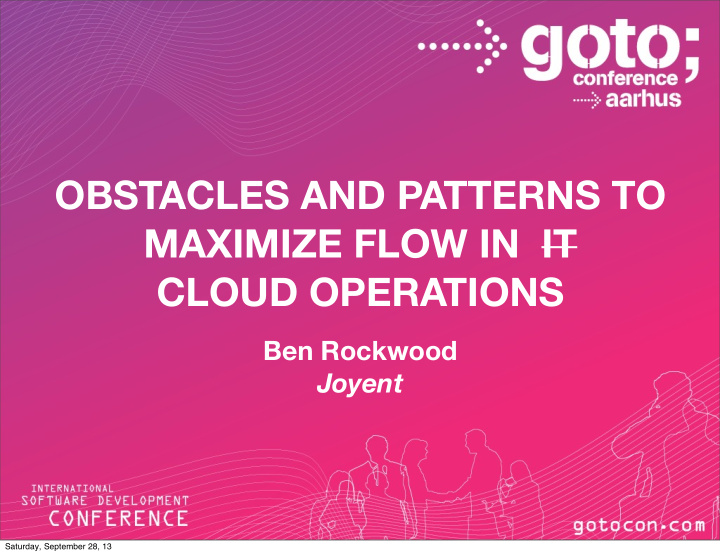



OBSTACLES AND PATTERNS TO MAXIMIZE FLOW IN IT CLOUD OPERATIONS Ben Rockwood Joyent Saturday, September 28, 13
Saturday, September 28, 13
Saturday, September 28, 13
Saturday, September 28, 13
The DevOps Flow Service Software Ops Requirements Dev Customers Saturday, September 28, 13
Goods & Services • Goods are things (“artifacts”) • Services are actions on behalf of another Saturday, September 28, 13
The DevOps Flow Service Software Ops Requirements Dev Customers Saturday, September 28, 13
Systems Thinking • A system is a whole that cannot be divided into independent parts • The essential properties of a system are those which none of its parts have • A system is not the sum of the behavior of its parts, but its the product of their interactions Dr. Russell Ackoff Saturday, September 28, 13
The DevOps Flow Service Software Ops Requirements Dev Customers Saturday, September 28, 13
DevOps Components • Collaboration of People • Convergence of Process • Creation & Exploitation of Tools Saturday, September 28, 13
The DevOps Flow Service Software Ops Requirements Dev Customers Saturday, September 28, 13
Flow in Action Saturday, September 28, 13
Beginning the Journey Saturday, September 28, 13
Pattern 1 : Start with why. • The key to doing anything well is “intentionality” • The means to become intentional is to have a singular set of goals and values • To discover these, we must “ Start with Why ” (Sinek) • “Systems” which are not designed are usually bad and broken systems. Saturday, September 28, 13
Pattern 2 : Build Trusting Relationships • “When we’re with people who believe what we believe, trust emerges.” (Sinek) • Have honest one-on-one discussions with peers outside the office • Particularly import for leaders • NOTE : You don’t need to be “friends”, but you must be peers and not enemies. Saturday, September 28, 13
Pattern 3 : Share the Vision & Align the Culture • Spread the “Why”, ensure they “get it” • Extend personal trust and respect throughout the organization • Propagate a flow based vision built on systems thinking that is customer focused • Ensure every employee understand the customer your trying to reach • If people aren’t on board, trim them now Saturday, September 28, 13
Pattern 4 : Value Stream Mapping • Fundamentally, we: • Start with resources • Value is added through a variety of phases • Provide it to a customer • This is the internal “system”, visualize it Saturday, September 28, 13
Pattern 5 : Standardize Work • Document your processes for each stage of the value stream • Employees should never struggle to know what to do • If you don’t do work in a standardized way, you’ll never find flaws in the process Saturday, September 28, 13
Pattern 6 : Manage Flow in the Value Stream • Kanban is an excellent means of visualizing the flow of work through “work centers” (groups) • Tickets alone are not enough! • Can work in tandem with ITIL Change Management • Will vary considerably from company to company depending on methodologies Saturday, September 28, 13
Pattern 7 : Muda (Eliminate Waste) • Any effort which is not adding value to the value stream is “muda” (waste, in Japanese literally “futility”) • Don’t do things just to do them • Examples: • Insufficient change data supplied to Ops • Excessive Meetings • Excessively large changes • Stamp out Muda using Kaizen Saturday, September 28, 13
Pattern 8 : Kaizen (Process Improvement) • Kaizen literally means “change for the better” • Use the PDCA cycle • True Kaizen is driven by stakeholders and empowered by management; those doing the work know how best to improve it! • We have a culture of personal responsibility and continuous improvement. Saturday, September 28, 13
PDCA & A3 Saturday, September 28, 13
A Kaizen Kaution: “Efficiency is doing things right; effectiveness is doing the right things.” Peter Drucker Saturday, September 28, 13
Pattern 9 : Jidoka (Quality at the Source) • Jidoka is “autonomous automation” • A philosophy of built in fault detection facilitating faster recovery • Practical examples: • Building idempotent tools • TDD, Automated Security Scanning, etc. • Clear error reporting & exception handling; fail-safes is possible • Monitoring, Alerting & Dashboards (Andon) Saturday, September 28, 13
Pattern 10 : Gemba (“Go and See”) • Managers: Don’t live in an ivy tower • Go spend time with other parts of the value stream, spend time using the product yourself, talking to customers • Avoid assumptions, investigate the situation for yourself! Saturday, September 28, 13
Pattern 11 : Practice & Teach Kata (Form) • “Practice Makes Perfect” • We must repeat the patterns again and again, and especially as leaders, teach them to others • “Kata Thinking” means not just leading your team using the Kata’s of Kaizen, Standardized Work, etc, but teaching them to use them • Kata is about building subconscious habits Saturday, September 28, 13
Be Intentional! Use Science! Practice, Practice, Practice Saturday, September 28, 13
Thank You. Saturday, September 28, 13
Recommend
More recommend